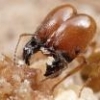Being in a neighboring town of you, hope this helps:
Back at the end of May, I noticed that Camponotus flew pretty much all together on the same nights; there were a few smaller flights, but a huge flight on May 26th starting a couple hours before sunset. I also noticed 2015 about the same night for camponotus flying as well (at least within a few days.) Prior there were a couple smaller flights, but the major nuptial flight was pretty noticeable (of almost biblical proportions) and other's from PA thru the North East in the AC forum reported seeming them. That night I observed:
- One or two species of Camponotus Myrmentoma (saw about a dozen or so)
- Camponotus Pennsylvanicus (for me the most popular spotted)
- Camponotus Novaeboracensis (only saw 1 or 2 of these.)
- Camponotus Americanus (only saw 2 or 3 of those flying, but managed to catch a couple for another member)
- Camponotus Herculeanus - I have not seen any of these (ever), guessing location and popularity of Camponotus Pennsylvanicus are the reason for this.
I took a look at the weather history at my station, and on May 24th we got over 1" of rain over the course of the day, and May 25 and 26th were hot (upper 80s.) Tip: Once you see them flying, don't stop hunting, even after dark. Around 8-9pm, they were moving in HUGE numbers along lawn and driveway. Very easy spotting with a flash light and almost impossible not to step on (it had a high-creep factor due the amount of queens).
I kept pretty good logs last year and weather data for these, so hit me up for details:
- Myrmica - First spotted 7/14 late afternoon some heavy Temnothorax nuptial flights the previous nights (unknown if recent alates or were foraging as no wings.) Flew a few days during the week of 9/8 spotted in the afternoon several Myrmica alates (male and female) flying. Tip: Many caught stuck to a hammock or in a tiny kiddie pool. Several Lasius species started flying at the same time.
- Ponera Pennsylvanica - Started seeing them flying with the Lasius on 8/27. On and off for about a week or two. Usually later afternoon and early evening.
-
Lasius Flavus and Lasius nearcticus - Spotted with the above Myrmica in early Sept. They flew mid to late afternoon (was interesting to see colonies normally hidden underground popping up in random places). In contrast, I noticed most of the L. Alienus and L. Neoniger flying in the later evening, and super easy to catch just after sunset with a flashlight as they looked for places to hide.
I'm not much of a morning person, but would often find dead Crematogaster alates in the late morning.
EDIT: Pheidole also on my list, but didn't see any last year. Not sure if related to environment, or poor flying conditions. I read on the forum here they usually fly after a heavy thunderstorm in the later afternoon, and fly when still wet outside. However with the drought we had last season, that almost never happened.
EDIT2: Pretty much all of these were found in a rural location, surrounded by heavy oak/pine woods, a small swamp, and a large pond near by. No real fields near by. There is a granite quarry, and majority of what I see there are Lasius, and some other super-fast moving large-ish red ant I haven't ID'ed yet.
Edited by noebl1, January 1 2017 - 8:38 AM.
![]()
![]()






















